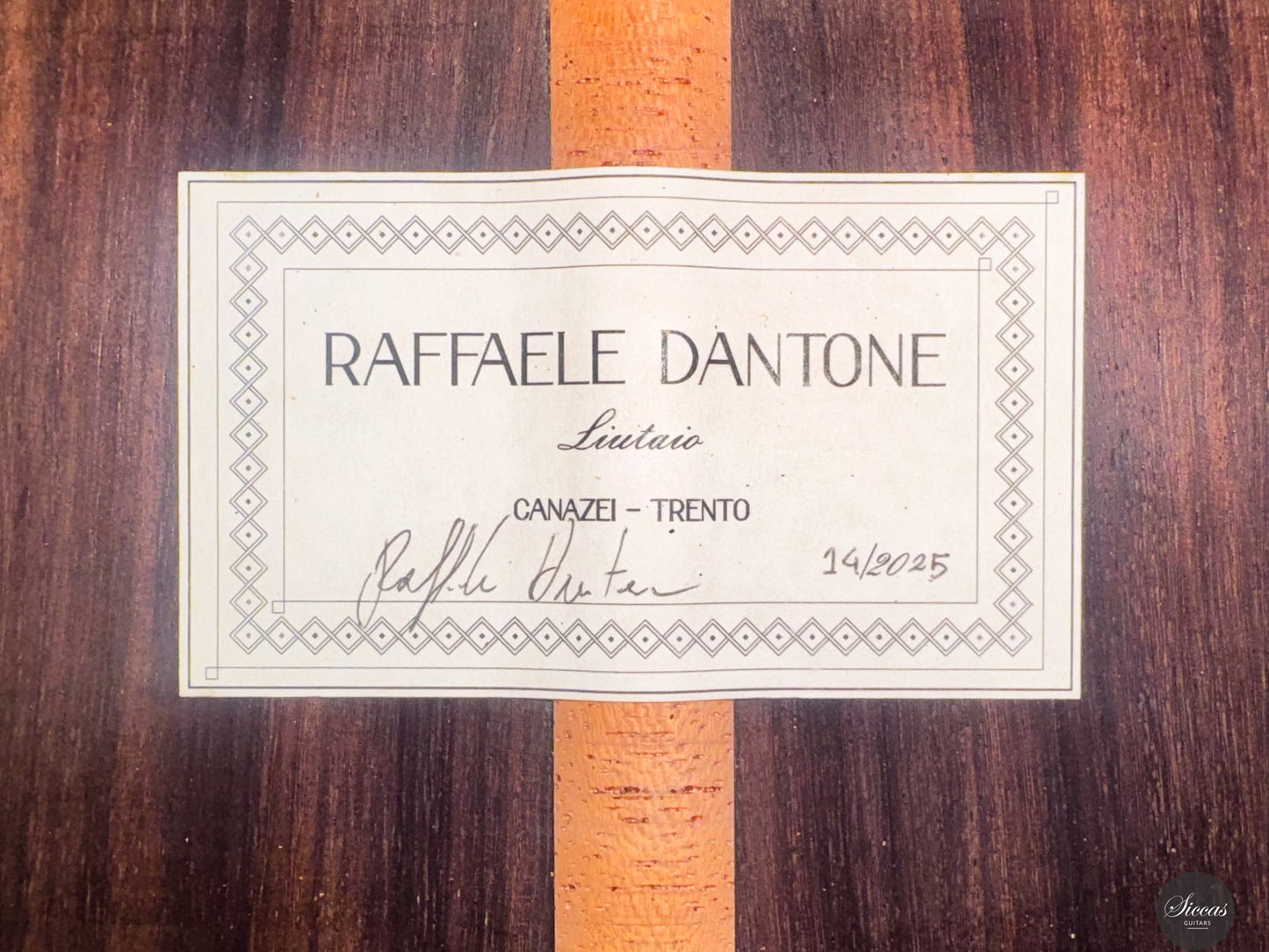Raffaele Dantone - 2025 - No. 14
Raffaele Dantone - 2025 - No. 14
Details
Details
Overview
Overview
Shipping important note
Shipping important note
Delivery times are typically reliable and most instruments arrive within the estimated timeframe.
Should any unexpected delay occur, our team will keep you informed and provide support at every step. For all shipping details and exceptions, please see our Shipping Policy.
Details about GPSR
Details about GPSR

























Video overview


More details about the guitar
About the luthier:
Italian luthier Raffaele Dantone builds his instruments in Canazei, in the Dolomites, where he combines a strong respect for the Torres and Bouchet traditions with his own ongoing research. His guitars are characterized by carefully selected tonewoods, refined craftsmanship, and an approach that emphasizes clarity, projection, and expressive range. Each instrument reflects his continuous exploration of bracing concepts and soundboard architecture, aimed at balancing power with the warmth and beauty of a traditional voice.About the guitar:
This 2025 concert guitar, numbered 14, marks a further step in Dantone’s evolution as a maker. It features a five-fan bracing system, a departure from the seven-fan layout he employed earlier, with the goal of achieving greater projection and tonal purity. Some of the braces are made of local spruce while others are of aged larch, complemented by an under-bridge sound bar. With its spruce top and Indian rosewood back and sides, the instrument has an air body resonance around G, offering a powerful yet elegant voice. The rosette design has been simplified to emphasize the natural beauty of the wood, and the slightly elevated fingerboard, with increased ebony thickness, allows both improved comfort in the higher positions and future adjustability while preserving a traditional appearance. The result is a guitar with a brilliant, full sound, remarkable clarity between voices, and a very wide dynamic range. It offers both immediate response and ample headroom, making it suitable for intimate playing as well as concert projection. This instrument demonstrates how Dantone’s work, inspired by Torres and Bouchet, has matured into a personal style of great distinction.Regular care extends the life of the instrument
Even with careful use, a classical guitar may gradually change in appearance or respond to unstable storage conditions. Have a close look at your guitar regularly and be attentif to changes. If your instrument is suffering from its environement, it will let you know.
Protect Your Guitar: Handle with Care
Be mindful when touching your instrument with greasy or unwashed hands: any skin contact is a small attack on the varnish. Of course, a guitar is made to be played, but taking a few precautions helps preserve its beauty: wash your hands before playing, wear long sleeves, and avoid unnecessary direct skin contact with the body of the instrument.
Pro tip: Avoid playing with a button-up shirt, heavy jewelry, or a belt, as these can scratch the guitar. Also, make sure your guitar case is free of any objects that could damage the instrument during storage.
String care
A good habit to adopt is wiping down your strings briefly after each playing session. This small action significantly extends their lifespan and helps maintain a consistent, comfortable feel under your fingers.
Most importantly, clean strings are essential for keeping your instrument in tune. Corrosion, sweat, and dust can affect the uniformity of the strings and interfere with accurate tuning across the entire fingerboard.
Pro tip: If you're having trouble getting your guitar in tune, it might be time to change the strings. A useful test is to compare the pitch of the 12th fret harmonic with the fretted note at the 12th fret; if there's an unusually large gap between them, your strings may have lost their integrity and should be replaced.
Keep Your Shellac Finish Shining!
Got a guitar with a shellac (French polish) finish? Here's a simple trick: Take a clean microfiber cloth and gently breathe on the surface to create a light mist. Then, softly rub to remove fingerprints, sweat, and grease. That’s usually all it takes to keep it looking great, no products needed!
Pro tip: Every few years, treat your guitar to a check-up with a luthier to keep it in top shape.
Storing Your Guitar: Climate Matters
Your guitar can safely stay outside its case, as long as the surrounding environment maintains 42–55% humidity and a temperature between 18–25°C.
Keep in mind that humidity levels can still fluctuate inside the case, especially during seasonal changes.
- Too much humidity may cause overtightened strings and a dull tone.
- Too little humidity can lead to a bulging top, string buzz, or even cracks.
Avoid placing your guitar near radiators, air conditioners, or windows with direct sunlight.
Pro tip: Always close your guitar case while playing. This helps preserve a stable microclimate inside the case, so your instrument is protected the moment you put it back in.





















































